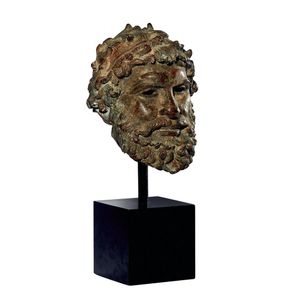Bronze Head of Boxer/Satyr, After Silanion (19th Century)
A Grand Tour bronze head of a boxer or satyr, late 19th century, after the original attributed to Silanion held in the National Archaeological Museum, Athens. Height 39 cm (including base). Provenance: Private Collection, Sweden. Private Collection, Southern Highlands
You must be a subscriber, and be logged in to view price and dealer details.
Subscribe Now to view actual auction price for this item
When you subscribe, you have the option of setting the currency in which to display prices to $Au, $US, $NZ or Stg.
This item has been sold, and the description, image and price are for reference purposes only.
- Attributed - A cataloguing term where the item in the opinion of the cataloguers, is a of the period of the artist, craftsman or designer, and which probably in whole or part is the work of that person.
- Bronze - An alloy of copper and tin, traditionally in the proportions of about 9 parts of copper to 1 part of tin.
The discovery of bronze in Western Asia in the 4th century enabled people to create metal objects which were superior to those previoulsy possible because of its strength and hardness, and it has been used throughout the world for weapons, coins, tools, statuary and other decorative items.
It is very fluid in a molten state, and its hardness, strength when set, and non-corrosive properties makes it most suitable for casting sculpture. - Satyr - A creature from Greek mythology with goat-like features, including a bearded face and horns, a man's torso, hairy legs and cloven hooves and a tail. As attendants of Bacchus, satyrs sometimes carry grapes or pitchers of wine. As spitis of fertility they may carry a cornucopia or basket of fruit.
They are also used to portray lust, and are often depicted with a leering expression. As well as being depicted singly or in a group in sculpture and candelabra, they also appear as motifs on ceramics, glass, silver and gold objects.
This item has been included into following indexes:
